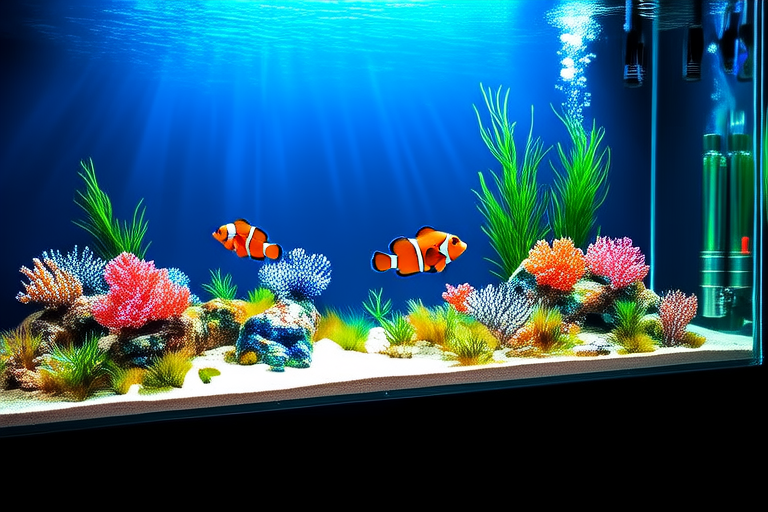DIY Clownfish Habitat: Tips for Setting Up the Perfect Aquarium
Introduction
Welcome to your guide on creating the perfect aquarium habitat for clownfish! This comprehensive tutorial will walk you through all the steps needed to set up an environment that ensures the health and happiness of your clownfish. From choosing the right tank size to maintaining optimal water conditions, we’ll cover everything you need to know to create a thriving aquatic ecosystem.
Tank Size Recommendations
Clownfish are relatively small fish, but they still require adequate space to swim and thrive. For one or two clownfish, a minimum tank size of 30 gallons (114 liters) is recommended. However, if you plan to keep multiple clownfish or add other marine species, a larger tank of at least 55 gallons (208 liters) is advisable. A bigger tank provides more stability in water parameters and allows for better swimming space.
Water Quality Maintenance Tips
Maintaining excellent water quality is crucial for the well-being of your clownfish. Here are some key tips:
- Regular Water Changes: Perform weekly partial water changes of about 10-15% to remove accumulated toxins and maintain water clarity.
- Monitoring Parameters: Use test kits to regularly check ammonia, nitrite, nitrate, pH, and salinity levels. Ammonia and nitrite should be undetectable, while nitrates should remain below 20 ppm.
- Air Stones and Surface Agitation: Install air stones or powerheads to ensure proper oxygenation and gas exchange in the water.
Suitable Filtration Systems
Selecting the right filtration system is vital for maintaining clean and healthy water. Here are some options:
- Canister Filters: These external filters provide powerful mechanical, biological, and chemical filtration, making them ideal for larger tanks.
- Hang-On-Back (HOB) Filters: HOB filters offer good filtration capacity and are easier to install and maintain compared to canister filters.
- Refugiums: A refugium is an additional tank or section where macroalgae and beneficial organisms grow, helping to control nutrients and stabilize water quality.
Appropriate Lighting Conditions
Clownfish do not require intense lighting, but providing moderate light is essential for their overall health and the growth of live plants. Here’s what you need to know:
- Light Duration: Aim for 8-10 hours of light per day. Avoid exposing your tank to direct sunlight, as it can lead to excessive algae growth.
- Types of Lights: LED lights are energy-efficient and provide full spectrum lighting, which is beneficial for both clownfish and live plants.
Ideal Temperature and pH Levels
Maintaining stable water conditions is crucial for the health of your clownfish. Here are the ideal parameters:
- Temperature: Keep the water temperature between 76°F and 82°F (24°C and 28°C). Use a reliable heater with a thermostat to maintain this range.
- pH Levels: The pH should be between 8.1 and 8.4. Regularly test the pH and make adjustments if necessary using pH buffers or additives.
Necessary Decorations and Hiding Spots
Clownfish are territorial and benefit from having plenty of hiding spots. Here are some ideas:
- Live Rock: Live rock not only provides hiding spots but also serves as a natural filtration medium.
- PVC Pipes: PVC pipes can be arranged to form caves and tunnels, offering shelter for your clownfish.
- Plastic Plants: While real plants are preferable, plastic plants can also serve as hiding spots and enhance the aesthetic appeal of your tank.
Compatible Tank Mates
When selecting tank mates for your clownfish, choose species that share similar water conditions and temperament. Some suitable tank mates include:
- Banggai Cardinalfish: These peaceful fish are compatible with clownfish and add color to your tank.
- Yellow Tangs: Yellow tangs are hardy herbivores that help control algae growth.
- Blue Damselfish: Blue damselfish are active swimmers and can coexist peacefully with clownfish.
Suitable Live Plants
Adding live plants to your aquarium can enhance its beauty and provide additional benefits. Here are some suitable plant options:
- Caulerpa Taxifolia: This fast-growing macroalgae helps control nutrient levels and provides shade.
- Java Fern: Java fern is easy to care for and can thrive in a variety of water conditions.
- Hornwort: Hornwort is a robust plant that can handle different lighting conditions and provides shelter for small fish.
Feeding Frequency and Types
Feeding your clownfish properly is essential for their growth and health. Here are some feeding tips:
- Frequency: Feed your clownfish twice daily with small portions. Overfeeding can lead to poor water quality and health issues.
- Diet: Clownfish are omnivorous and enjoy a varied diet. Offer a mix of high-quality flake food, frozen foods like brine shrimp, and occasional treats such as mysis shrimp or bloodworms.
Preventing and Solving Common Health Issues
Despite your best efforts, clownfish may occasionally encounter health problems. Here are some common issues and how to address them:
- Fungal Infections: Fungal infections can occur due to poor water quality or injuries. Treat affected areas with antifungal medications and improve water conditions.
- Ich (White Spot Disease): Ich is a parasitic infection characterized by white spots on the fish. Increase water temperature to 82-86°F (28-30°C) for several days and treat with ich-specific medication.
- Fin Rot: Fin rot is caused by bacteria and can result from poor water quality or physical damage. Improve water conditions and treat with antibacterial medications.
Conclusion
Setting up a DIY clownfish habitat requires careful planning and attention to detail. By following these guidelines, you can create a thriving aquatic environment that supports the health and happiness of your clownfish. Remember to monitor water conditions regularly, provide appropriate decorations and hiding spots, and maintain a balanced diet. With proper care, your clownfish will thrive in their new home for years to come.
